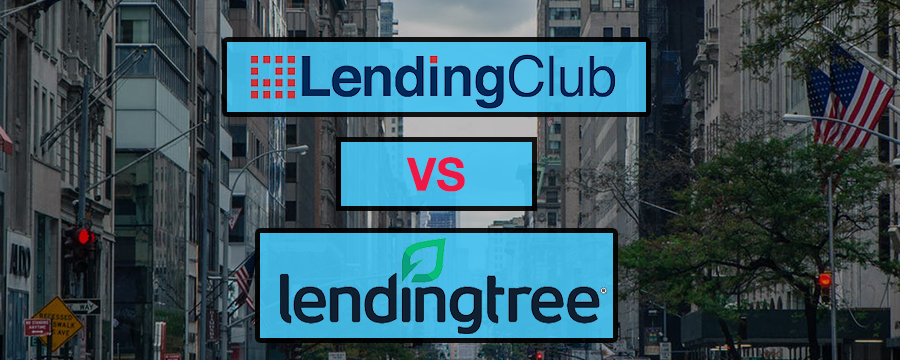Lending Club vs Lending Tree Personal Loans


By Braden Smith | December 17th, 2018 | Banking
This post may contain sponsored links, view the affiliate policy.
Personal loans are great for credit consolidation, big purchases, and even starting a business. Finding the best personal loan can be difficult, so we will compare two worthy candidates, LendingClub vs LendingTree. Despite the names of these lenders, they are not affiliated with each other and offer personal loans in different ways.
Quick find guide:
LendingClub vs LendingTree: An Overview
What’s required to apply for these lenders?
Which lender offers lower interest rates?
Which company is the most trustworthy?
Which lender has lower fees?
Which lender has the easiest (and fastest) process?
Which lender can provide the most funds?
Overall Winner: LendingTree
What type of borrower is LendingClub good for?
LendingClub vs LendingTree: An Overview
LendingClub is a Peer to Peer (P2P) lending company that provides a loan marketplace for borrowers and investors. This means that loans originate from investors looking to make a return on their money. This is a relatively new approach to lending, as they were founded in 2006.
Initially, LendingClub screens potential borrowers through a soft credit inquiry to appropriately give a rate. If the borrower decides to accept that rate, a hard credit inquiry will be made, which shows up on the borrowers credit report.
LendingTree is a popular online lending exchange who matches borrowers to banks and credit partners who compete for business. LendingTree has been in business since 1996, making them ten years older than LendingClub.
Unlike LendingClub, individual investors cannot lend their money on this platform. To screen borrowers, LendingTree makes a soft credit inquiry once a loan request has been accepted. This will not effect the credit score of the borrower.
 |
 |
|
|---|---|---|
| Lower interest rates | (winner for bad credit) | (winner for favorable credit) |
| Trust Score | ||
| Lower Fees | ||
| Easiest, Fastest Process | ||
| Most Funding | ||
| Winner | ||
What’s required to apply for these lenders?
Before you can apply to either lender, there are a few requirements that need to be met. It’s important to understand that the better the credit score, the less risk each lender is taking on the loan. The higher the credit score, the better the terms. Also note that some lenders don’t allow participants residing from outside of the United States.
Which lender offers lower interest rates?
Each lender uses different criteria when determining the interest rate of each loan. When a borrower has a favorable credit score above 700, the lender takes less of a risk of defaulting (not paying back the loan). Now compare this to a borrower with a fair 600 credit score. The lender will have a tough time giving a great interest rate as the possibility of default is relatively high.

LendingClub offers interest rates that start at 6.46% and go as high as 27.27%. Borrowers’ loan applications and credit reports are taken into consideration when given a specific Loan Grade. Loan Grades range from A1 to E5. Borrowers with excellent credit score and a low debt-to-income ratio generally qualify for A to B loans. Alternatively, borrowers with less than good credit and high debt-to-income-ratios will be given lower loan grades, in the D to E range.

LendingTree interest rates vary depending on the specifically matched lender (which could be any bank). Generally, rates range from 6% to 40%. Borrowers are encouraged to approach LendingTree with a good credit score to secure a low-interest rate. Those with bare minimum scores are not afforded the luxury of having a low rate due to the potential risk of default. Unlike LendingClub, borrowers are able to choose between different lenders to find the best fitting rate.
LendingClub offers lower rates for borrowers with less than perfect credit compared to LendingTree. Even though LendingTree has many options to choose from, 40% interest rates are pretty steep. For those with great or perfect credit, it’s quite a tossup between the two lenders. They offer low rates in the 6% range. But when all types of borrowers are taken into consideration, LendingClub is a clear winner.
Between both lenders, who is the most trustworthy?
A wide range of things can happen during the process of obtaining and paying back a personal loan. Here we will look at which company resolves problems most efficiently and how customers are affected. Searching through different ratings websites, the Better Business Bureau, and multiple phone calls, here are the results.
While many ratings are mostly negative for LendingClub, they continue to operate a trustworthy business. However, according to the websites surveyed, LendingTree does a better job helping its customers resolve their issues. LendingTree also has a better BBB rating, as well as a higher rating on Trustpilot.
Which lender has lower fees?
Companies may not advertise all of their fees, so it is important to understand what you will be paying over the course of the loan. Understanding the fee structure will ensure that you save money while getting what you want. Here we will review what each company is charging for fees, and what it could cost a borrower.

Borrowers at LendingClub will incur an origination fee on their personal loan. This fee can range anywhere between 1.00% and 6.00% and depends on the credit rating and application. The origination fee is included within the Annual Percentage Rate (APR) and is deducted from their loan upon issuance. Late fees are charged when borrowers fail to make loan payments on time.
Borrowers may pay:
- Origination fee
- Late fee
Borrowers do not pay:
- Prepayment fee
- Application fee
- Brokerage fee

Since LendingTree matches borrowers to lenders, LendingTree does not have full control over what fees will be charged. Borrowers may be subjected to a variety of different fees. On the upside, LendingTree does not charge any “upfront fees”, or frees that stem from matching borrowers to lenders.
Borrowers may pay:
- Interest rate lock fee
- Application fee
- Appraisal fee
- Origination fee
- Late fee
Borrowers do not pay:
- Service matching fee
- Brokerage fee

Weighing the pros and cons of each of the fees that both companies charge, LendingClub comes out on top. Paying a simple origination fee that’s calculated into the overall APR is simple and convenient. LendingTree borrowers need to worry about the potential pitfalls of all the potential fees charged by the underlying lenders.
Which lender has the easiest (and fastest) process?
Sometimes borrowers need their money fast. Getting offers quickly can save time and expedite the process of getting funded. Lenders try to work with borrowers to find solutions to their problems and fund their loans as quickly as possible.

The entire process is simple, it first starts with the borrower signing up on the website. Once that has been done, and the account has been set up, the borrower may then choose from a list of offers. These offers differ in APR, term, and amount borrowed. Once the borrower has selected a favorable loan, they are then required to complete the application and verify information. Getting the money takes about 7 days, and in some cases, longer.

First, LendingTree borrowers will need to sign up on the website. Then they will need to provide sufficient credit information and documentation to LendingTree. Once that has been completed, the borrower may then evaluate lender offers and find the right rate. If favorable terms have been found, the borrower then contacts the lender and gets funded. If done efficiently, this whole process could lead to having cash in hand in under 24 hours.
The process for both lenders seems to be pretty simple and straightforward. However, LendingTree borrowers could receive funds in under 24 hours, while LendingClub borrowers must wait up to 7 days. Those looking to get a loan in as little time as possible should choose LendingTree.
Which lender can provide the most funds?
Borrowers sometimes need a large sum of money to fund their business, pay back credit card bills, or pay tuition for school. Looking at the maximum possible funds that borrowers can get is important for figuring out which lender to choose.

First, LendingClub makes a risk analysis on the borrower to see their trustworthiness. Second, they look at the loan application to determine an appropriate rate for the borrower. Then, depending on the credit score of the borrower, the loan amount could range from $1,000 to $40,000. Borrowers may also qualify for a second loan, which is essentially having two active personal loans at once. If the borrower is eligible, they will receive an invitation.

Borrowers have a lot of options when it comes to LendingTree’s maximum loan amount. Since outside lenders create offers for the borrower, it’s possible to get up to $100,000. Most of the lending institutions offer loans with amounts between $1,000 and $50,000. This all depends on the creditworthiness and risk of the borrower. LendingTree does not advertise second loans on their website. By contacting customer support, this may be possible to achieve.
LendingTree can offer borrowers up to $100,000 under certain circumstances. This is much more than LendingClub’s maximum of $40,000. Borrowers looking to secure a small personal loan of a few thousand dollars will not have a problem choosing either lender. But for the sake of taking into account all borrowers, LendingTree is a clear winner.
Overall Winner: LendingTree
LendingTree has many accolades and provides more options than LendingClub. First off, LendingTree has a higher BBB rating and Trustpilot score. Statistically, this means that borrowers feel safer choosing LendingTree than LendingClub. Not to mention, LendingTree has been around 10 years longer than its competitor.
Borrowers may secure personal loans for up to $100,000 in as little as 24 hours. This is very convenient for people who need quick cash, effectively avoiding payday loans and other predatory lenders. Also, LendingTree caters to individuals who need a large some of money.
For borrowers with good to perfect credit, LendingTree is an outstanding winner in this comparison of LendingClub vs Lending Tree.
What type of borrower is LendingClub good for?

LendingClub may be a favorable option for those who need access to small loans, without an emphasis on the time it takes to receive funding. If borrowers have bad credit, they may be inclined to try LendingClub, as their interest rates are a bit lower. LendingClub borrowers may incur fewer fees, but also weigh the risk of having a bad experience with the company. These borrowers are also limited to the variety of loan offers they can get. But when comparing LendingClub vs LendingTree, it could be better.

